Analysis of Labor Relations and Unions in America and Canada
VerifiedAdded on 2021/06/18
|5
|1140
|44
Report
AI Summary
This report delves into the intricacies of labor relations, contrasting the systems of the United States and Canada. It begins by differentiating mainstream economics, industrial relations, human resource management, and critical labor relations, highlighting the role of unions and employee voice in each. The report then outlines the key legislation governing the American labor system, including the National Labor Relations Act, the Taft-Hartley Act, and the Landrum-Griffin Act, detailing their respective impacts on employer and employee rights. It also examines the challenges faced by the American labor relations and management system, such as distrust and bureaucratic hurdles. A significant portion of the report is dedicated to comparing American and Canadian labor unions, identifying similarities in goals and legal requirements while highlighting differences in union membership, employee rights, and financial disclosure practices. The analysis draws upon relevant sources to support its claims, providing a comprehensive overview of the subject matter.
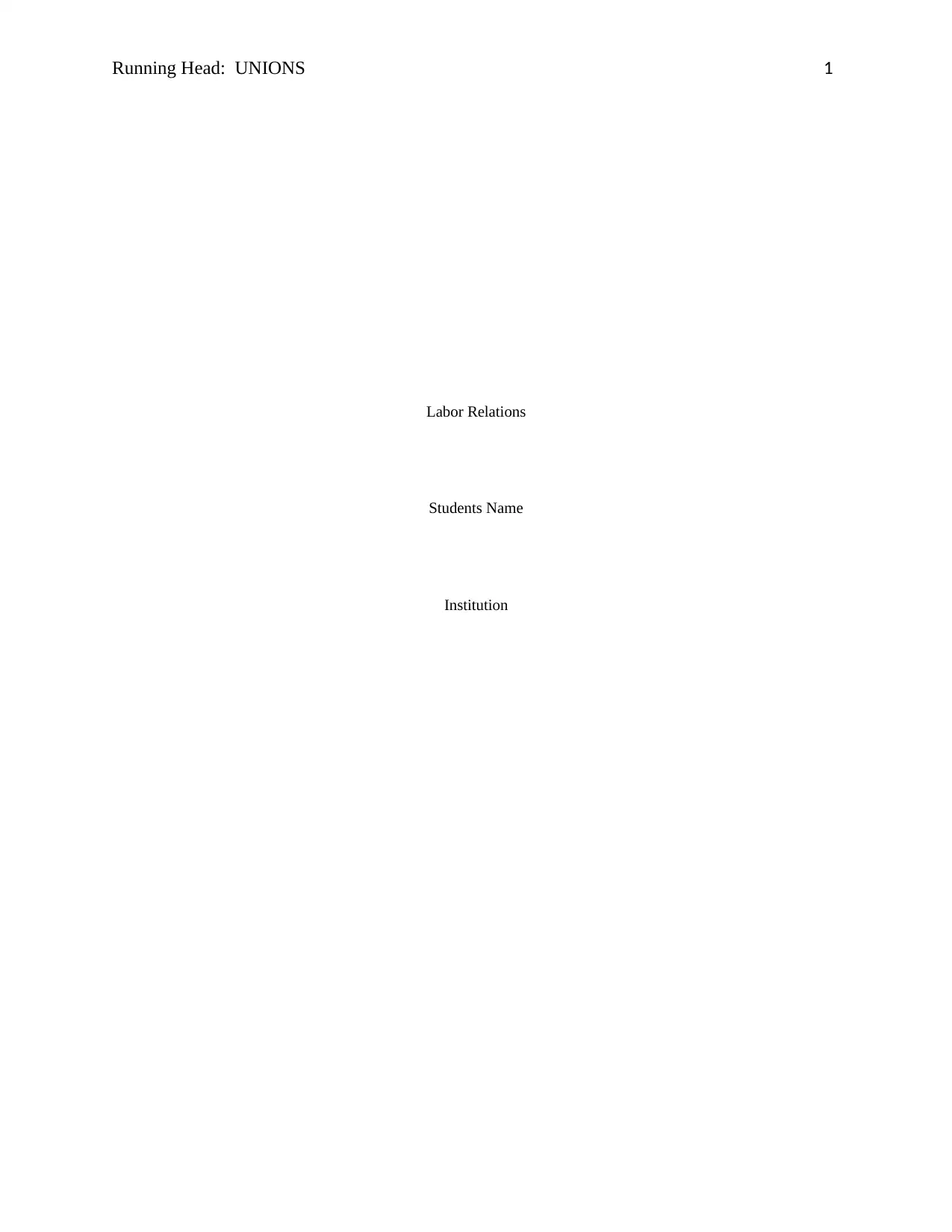
Running Head: UNIONS 1
Labor Relations
Students Name
Institution
Labor Relations
Students Name
Institution
Paraphrase This Document
Need a fresh take? Get an instant paraphrase of this document with our AI Paraphraser
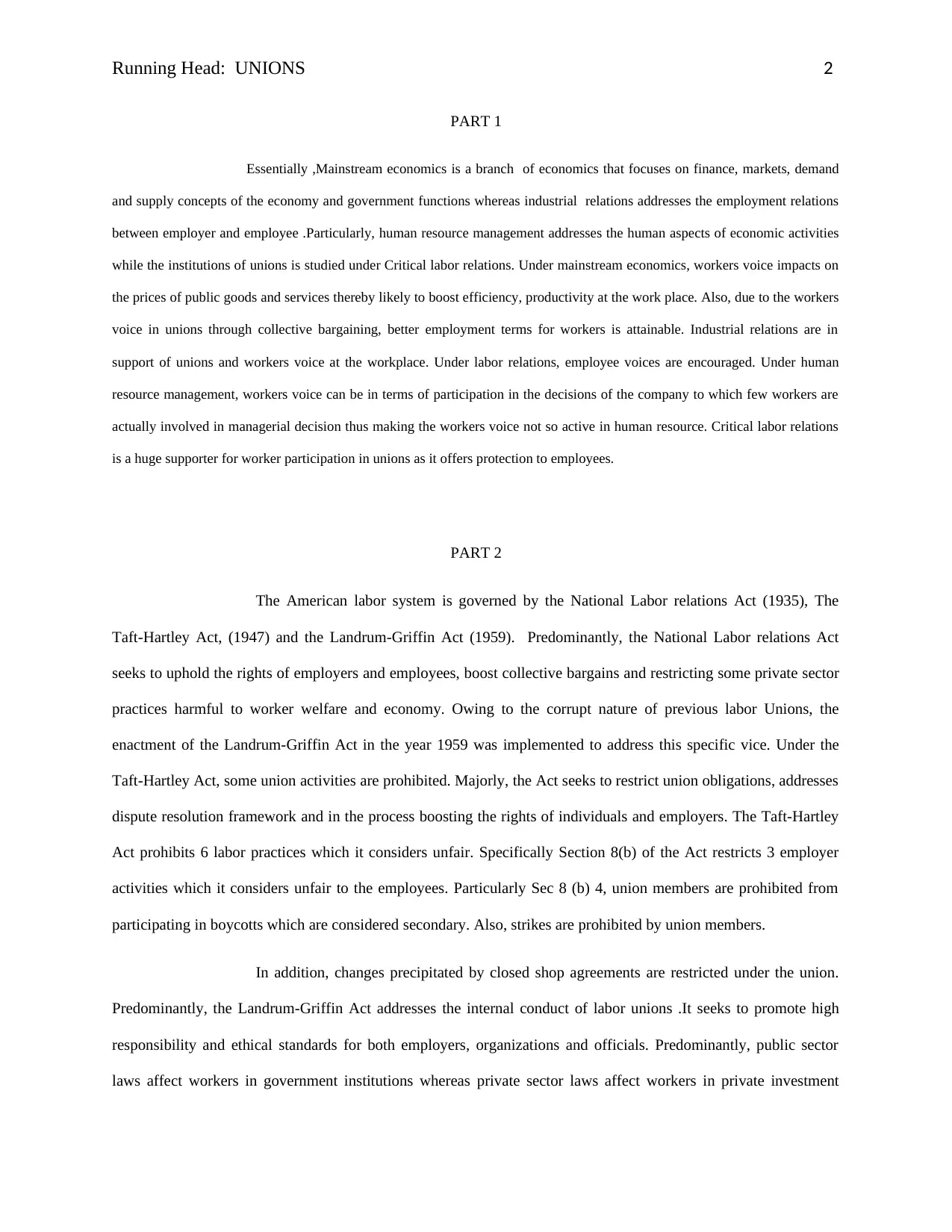
Running Head: UNIONS 2
PART 1
Essentially ,Mainstream economics is a branch of economics that focuses on finance, markets, demand
and supply concepts of the economy and government functions whereas industrial relations addresses the employment relations
between employer and employee .Particularly, human resource management addresses the human aspects of economic activities
while the institutions of unions is studied under Critical labor relations. Under mainstream economics, workers voice impacts on
the prices of public goods and services thereby likely to boost efficiency, productivity at the work place. Also, due to the workers
voice in unions through collective bargaining, better employment terms for workers is attainable. Industrial relations are in
support of unions and workers voice at the workplace. Under labor relations, employee voices are encouraged. Under human
resource management, workers voice can be in terms of participation in the decisions of the company to which few workers are
actually involved in managerial decision thus making the workers voice not so active in human resource. Critical labor relations
is a huge supporter for worker participation in unions as it offers protection to employees.
PART 2
The American labor system is governed by the National Labor relations Act (1935), The
Taft-Hartley Act, (1947) and the Landrum-Griffin Act (1959). Predominantly, the National Labor relations Act
seeks to uphold the rights of employers and employees, boost collective bargains and restricting some private sector
practices harmful to worker welfare and economy. Owing to the corrupt nature of previous labor Unions, the
enactment of the Landrum-Griffin Act in the year 1959 was implemented to address this specific vice. Under the
Taft-Hartley Act, some union activities are prohibited. Majorly, the Act seeks to restrict union obligations, addresses
dispute resolution framework and in the process boosting the rights of individuals and employers. The Taft-Hartley
Act prohibits 6 labor practices which it considers unfair. Specifically Section 8(b) of the Act restricts 3 employer
activities which it considers unfair to the employees. Particularly Sec 8 (b) 4, union members are prohibited from
participating in boycotts which are considered secondary. Also, strikes are prohibited by union members.
In addition, changes precipitated by closed shop agreements are restricted under the union.
Predominantly, the Landrum-Griffin Act addresses the internal conduct of labor unions .It seeks to promote high
responsibility and ethical standards for both employers, organizations and officials. Predominantly, public sector
laws affect workers in government institutions whereas private sector laws affect workers in private investment
PART 1
Essentially ,Mainstream economics is a branch of economics that focuses on finance, markets, demand
and supply concepts of the economy and government functions whereas industrial relations addresses the employment relations
between employer and employee .Particularly, human resource management addresses the human aspects of economic activities
while the institutions of unions is studied under Critical labor relations. Under mainstream economics, workers voice impacts on
the prices of public goods and services thereby likely to boost efficiency, productivity at the work place. Also, due to the workers
voice in unions through collective bargaining, better employment terms for workers is attainable. Industrial relations are in
support of unions and workers voice at the workplace. Under labor relations, employee voices are encouraged. Under human
resource management, workers voice can be in terms of participation in the decisions of the company to which few workers are
actually involved in managerial decision thus making the workers voice not so active in human resource. Critical labor relations
is a huge supporter for worker participation in unions as it offers protection to employees.
PART 2
The American labor system is governed by the National Labor relations Act (1935), The
Taft-Hartley Act, (1947) and the Landrum-Griffin Act (1959). Predominantly, the National Labor relations Act
seeks to uphold the rights of employers and employees, boost collective bargains and restricting some private sector
practices harmful to worker welfare and economy. Owing to the corrupt nature of previous labor Unions, the
enactment of the Landrum-Griffin Act in the year 1959 was implemented to address this specific vice. Under the
Taft-Hartley Act, some union activities are prohibited. Majorly, the Act seeks to restrict union obligations, addresses
dispute resolution framework and in the process boosting the rights of individuals and employers. The Taft-Hartley
Act prohibits 6 labor practices which it considers unfair. Specifically Section 8(b) of the Act restricts 3 employer
activities which it considers unfair to the employees. Particularly Sec 8 (b) 4, union members are prohibited from
participating in boycotts which are considered secondary. Also, strikes are prohibited by union members.
In addition, changes precipitated by closed shop agreements are restricted under the union.
Predominantly, the Landrum-Griffin Act addresses the internal conduct of labor unions .It seeks to promote high
responsibility and ethical standards for both employers, organizations and officials. Predominantly, public sector
laws affect workers in government institutions whereas private sector laws affect workers in private investment
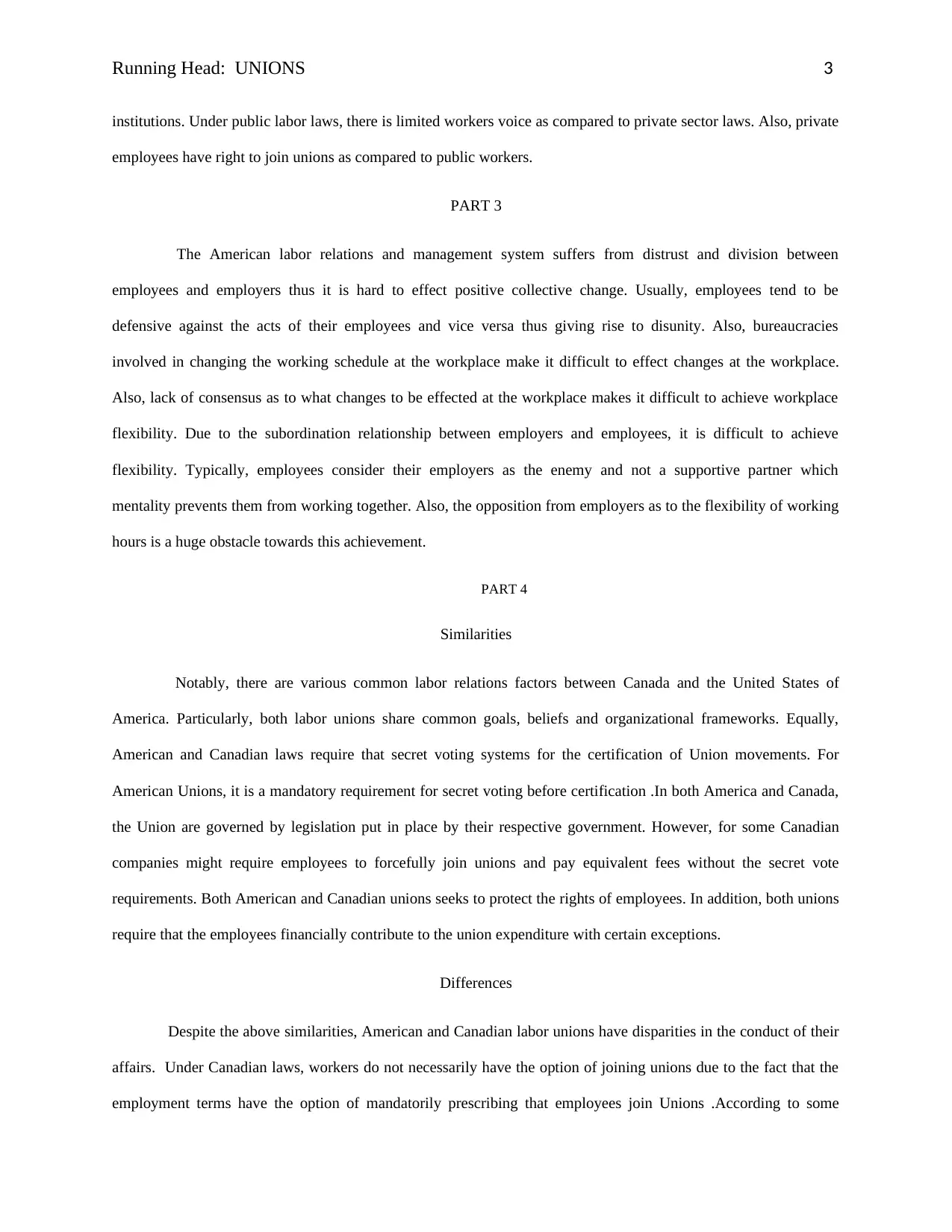
Running Head: UNIONS 3
institutions. Under public labor laws, there is limited workers voice as compared to private sector laws. Also, private
employees have right to join unions as compared to public workers.
PART 3
The American labor relations and management system suffers from distrust and division between
employees and employers thus it is hard to effect positive collective change. Usually, employees tend to be
defensive against the acts of their employees and vice versa thus giving rise to disunity. Also, bureaucracies
involved in changing the working schedule at the workplace make it difficult to effect changes at the workplace.
Also, lack of consensus as to what changes to be effected at the workplace makes it difficult to achieve workplace
flexibility. Due to the subordination relationship between employers and employees, it is difficult to achieve
flexibility. Typically, employees consider their employers as the enemy and not a supportive partner which
mentality prevents them from working together. Also, the opposition from employers as to the flexibility of working
hours is a huge obstacle towards this achievement.
PART 4
Similarities
Notably, there are various common labor relations factors between Canada and the United States of
America. Particularly, both labor unions share common goals, beliefs and organizational frameworks. Equally,
American and Canadian laws require that secret voting systems for the certification of Union movements. For
American Unions, it is a mandatory requirement for secret voting before certification .In both America and Canada,
the Union are governed by legislation put in place by their respective government. However, for some Canadian
companies might require employees to forcefully join unions and pay equivalent fees without the secret vote
requirements. Both American and Canadian unions seeks to protect the rights of employees. In addition, both unions
require that the employees financially contribute to the union expenditure with certain exceptions.
Differences
Despite the above similarities, American and Canadian labor unions have disparities in the conduct of their
affairs. Under Canadian laws, workers do not necessarily have the option of joining unions due to the fact that the
employment terms have the option of mandatorily prescribing that employees join Unions .According to some
institutions. Under public labor laws, there is limited workers voice as compared to private sector laws. Also, private
employees have right to join unions as compared to public workers.
PART 3
The American labor relations and management system suffers from distrust and division between
employees and employers thus it is hard to effect positive collective change. Usually, employees tend to be
defensive against the acts of their employees and vice versa thus giving rise to disunity. Also, bureaucracies
involved in changing the working schedule at the workplace make it difficult to effect changes at the workplace.
Also, lack of consensus as to what changes to be effected at the workplace makes it difficult to achieve workplace
flexibility. Due to the subordination relationship between employers and employees, it is difficult to achieve
flexibility. Typically, employees consider their employers as the enemy and not a supportive partner which
mentality prevents them from working together. Also, the opposition from employers as to the flexibility of working
hours is a huge obstacle towards this achievement.
PART 4
Similarities
Notably, there are various common labor relations factors between Canada and the United States of
America. Particularly, both labor unions share common goals, beliefs and organizational frameworks. Equally,
American and Canadian laws require that secret voting systems for the certification of Union movements. For
American Unions, it is a mandatory requirement for secret voting before certification .In both America and Canada,
the Union are governed by legislation put in place by their respective government. However, for some Canadian
companies might require employees to forcefully join unions and pay equivalent fees without the secret vote
requirements. Both American and Canadian unions seeks to protect the rights of employees. In addition, both unions
require that the employees financially contribute to the union expenditure with certain exceptions.
Differences
Despite the above similarities, American and Canadian labor unions have disparities in the conduct of their
affairs. Under Canadian laws, workers do not necessarily have the option of joining unions due to the fact that the
employment terms have the option of mandatorily prescribing that employees join Unions .According to some
⊘ This is a preview!⊘
Do you want full access?
Subscribe today to unlock all pages.

Trusted by 1+ million students worldwide
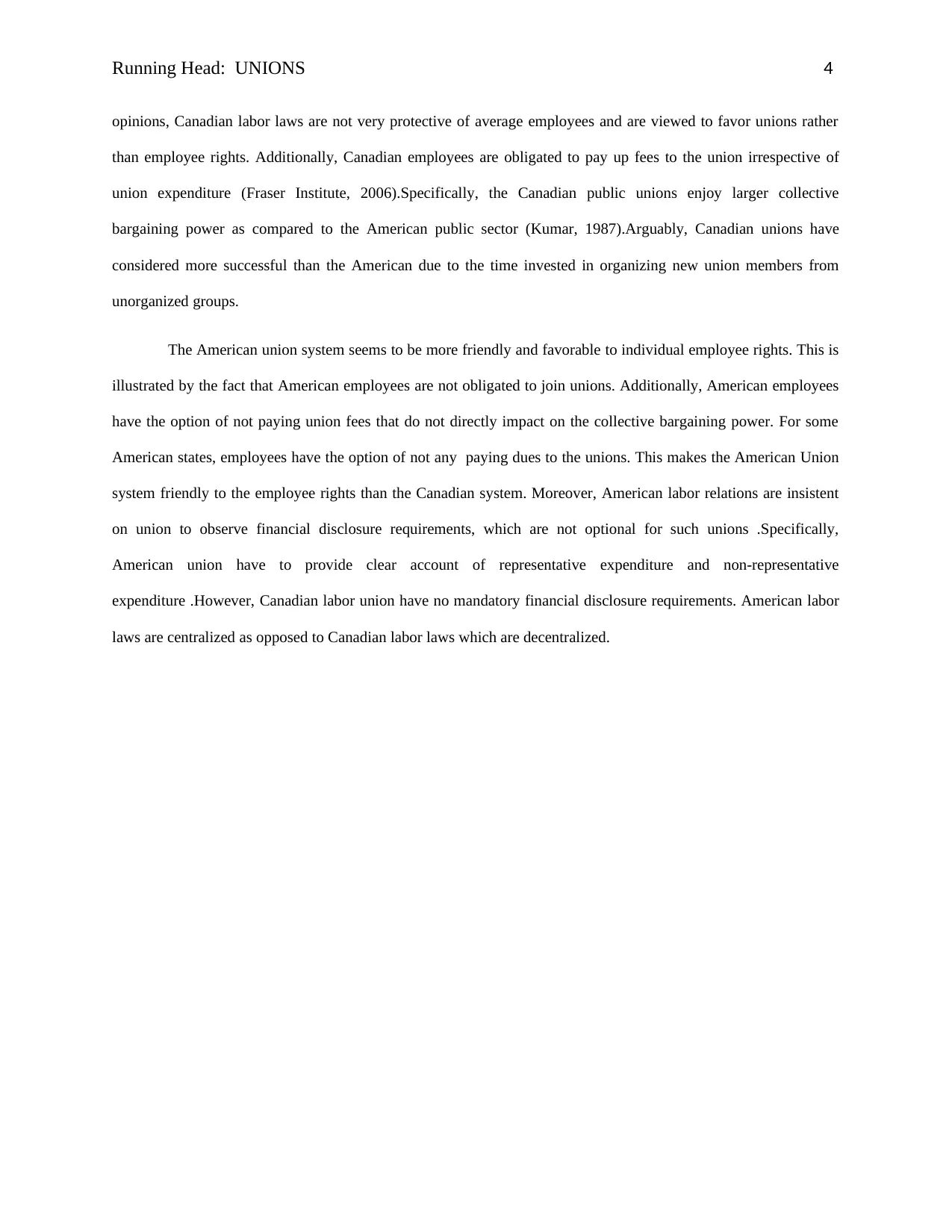
Running Head: UNIONS 4
opinions, Canadian labor laws are not very protective of average employees and are viewed to favor unions rather
than employee rights. Additionally, Canadian employees are obligated to pay up fees to the union irrespective of
union expenditure (Fraser Institute, 2006).Specifically, the Canadian public unions enjoy larger collective
bargaining power as compared to the American public sector (Kumar, 1987).Arguably, Canadian unions have
considered more successful than the American due to the time invested in organizing new union members from
unorganized groups.
The American union system seems to be more friendly and favorable to individual employee rights. This is
illustrated by the fact that American employees are not obligated to join unions. Additionally, American employees
have the option of not paying union fees that do not directly impact on the collective bargaining power. For some
American states, employees have the option of not any paying dues to the unions. This makes the American Union
system friendly to the employee rights than the Canadian system. Moreover, American labor relations are insistent
on union to observe financial disclosure requirements, which are not optional for such unions .Specifically,
American union have to provide clear account of representative expenditure and non-representative
expenditure .However, Canadian labor union have no mandatory financial disclosure requirements. American labor
laws are centralized as opposed to Canadian labor laws which are decentralized.
opinions, Canadian labor laws are not very protective of average employees and are viewed to favor unions rather
than employee rights. Additionally, Canadian employees are obligated to pay up fees to the union irrespective of
union expenditure (Fraser Institute, 2006).Specifically, the Canadian public unions enjoy larger collective
bargaining power as compared to the American public sector (Kumar, 1987).Arguably, Canadian unions have
considered more successful than the American due to the time invested in organizing new union members from
unorganized groups.
The American union system seems to be more friendly and favorable to individual employee rights. This is
illustrated by the fact that American employees are not obligated to join unions. Additionally, American employees
have the option of not paying union fees that do not directly impact on the collective bargaining power. For some
American states, employees have the option of not any paying dues to the unions. This makes the American Union
system friendly to the employee rights than the Canadian system. Moreover, American labor relations are insistent
on union to observe financial disclosure requirements, which are not optional for such unions .Specifically,
American union have to provide clear account of representative expenditure and non-representative
expenditure .However, Canadian labor union have no mandatory financial disclosure requirements. American labor
laws are centralized as opposed to Canadian labor laws which are decentralized.
Paraphrase This Document
Need a fresh take? Get an instant paraphrase of this document with our AI Paraphraser
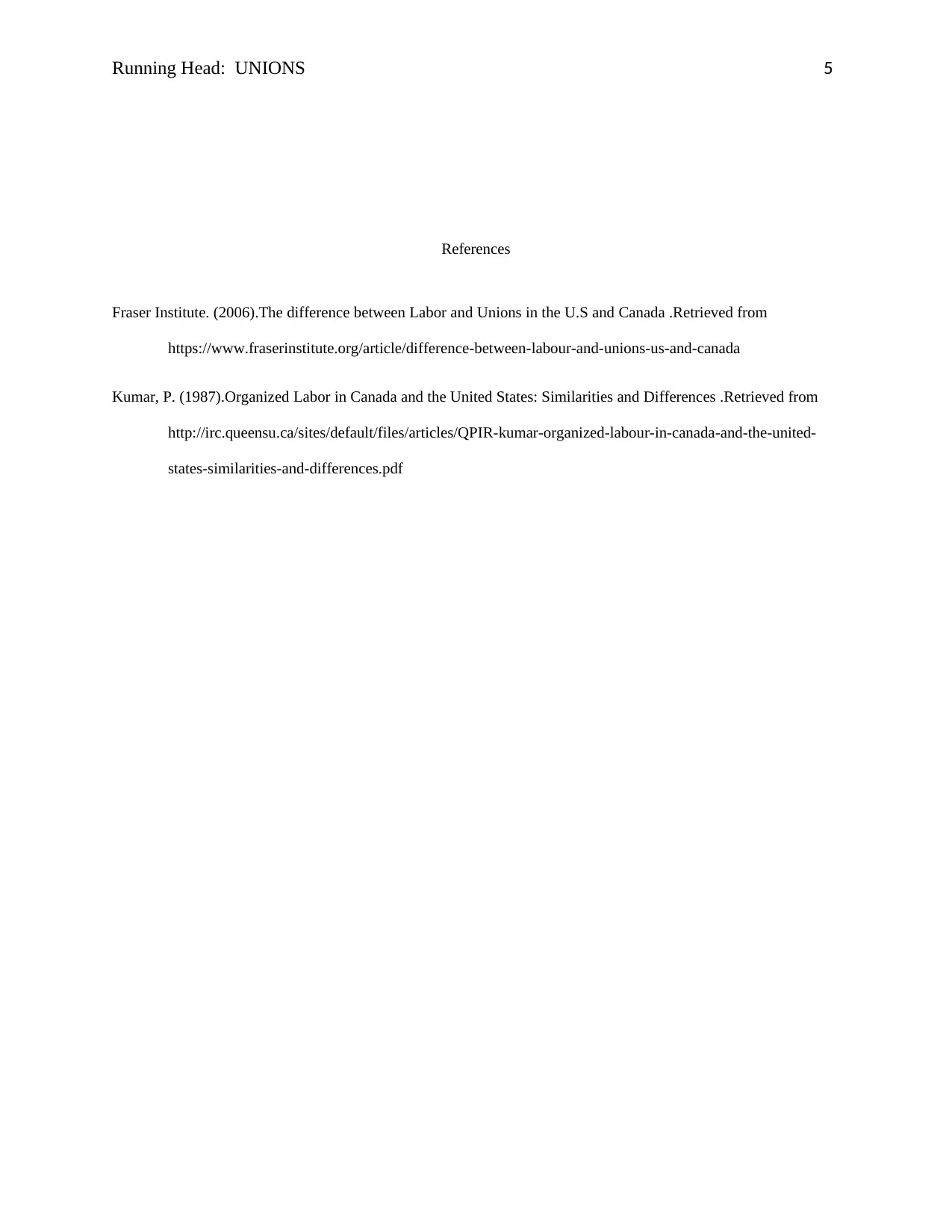
Running Head: UNIONS 5
References
Fraser Institute. (2006).The difference between Labor and Unions in the U.S and Canada .Retrieved from
https://www.fraserinstitute.org/article/difference-between-labour-and-unions-us-and-canada
Kumar, P. (1987).Organized Labor in Canada and the United States: Similarities and Differences .Retrieved from
http://irc.queensu.ca/sites/default/files/articles/QPIR-kumar-organized-labour-in-canada-and-the-united-
states-similarities-and-differences.pdf
References
Fraser Institute. (2006).The difference between Labor and Unions in the U.S and Canada .Retrieved from
https://www.fraserinstitute.org/article/difference-between-labour-and-unions-us-and-canada
Kumar, P. (1987).Organized Labor in Canada and the United States: Similarities and Differences .Retrieved from
http://irc.queensu.ca/sites/default/files/articles/QPIR-kumar-organized-labour-in-canada-and-the-united-
states-similarities-and-differences.pdf
1 out of 5
Related Documents
Your All-in-One AI-Powered Toolkit for Academic Success.
+13062052269
info@desklib.com
Available 24*7 on WhatsApp / Email
![[object Object]](/_next/static/media/star-bottom.7253800d.svg)
Unlock your academic potential
Copyright © 2020–2025 A2Z Services. All Rights Reserved. Developed and managed by ZUCOL.




